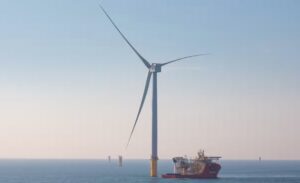The UK government has committed £265 million a year to support a range of renewable energy technologies in the upcoming fourth round of the country’s Contracts for Difference (CfD) auction system, which could help underpin up to £20 billion in new investment.
The UK Department for Business, Energy & Strategy (BEIS) on Monday outlined the specifics of its latest auction for building increased renewable energy capacity, marking the country’s “biggest ever” renewable support package and opens the door for all technologies to participate.
In previous Contracts for Difference rounds, specific “pots” of eligible renewable technologies excluded more mature technologies such as onshore wind and solar PV. However, for the first time since the first CfD round, onshore wind and solar will be able to bid on government support.
“The Contracts for Difference scheme has helped the UK become a world leader in clean electricity generation and lowered prices for consumers,” said Anne-Marie Trevelyan, UK Energy Minister.
“The new plans set out today deliver on the Prime Minister’s Ten Point Plan and will support the next generation of renewable electricity projects needed to power our homes and meet our world-leading climate change targets.”
The lion’s share of government support, however, is focused on offshore wind, which is eligible for £200 million annually.
Just as importantly, the offshore wind ‘pot’ will also have no capacity cap, opening the door for some potentially mammoth offshore wind farms in a country already known for huge offshore wind farms.
The UK government is currently aiming at building a 40GW offshore wind fleet, including 1GW of floating offshore wind, by 2030.
A further £10 million will be available in Pot 1 for more established technologies, including onshore wind, solar, and hydropower, while a further £55 million will be available for less-established technologies including floating offshore wind, tidal stream, geothermal, and wave power.
Floating offshore wind will get an extra boost in this fourth CfD round, with £24 ringfenced for bidding floating offshore wind projects – a strong sign of support for a potentially vital renewable technology.
Importantly, the “less established technologies” ‘Pot 2’ – segregated as it is from more popular and established technologies like onshore wind, solar, and offshore wind – could be a valuable opportunity for tidal stream power to take the next step towards large-scale commercialisation.
The world’s (currently) most powerful tidal turbine began operating and exporting power to the Scottish energy grid in July, well timed to garner government support and potential financial backing ahead of this fourth CfD round.
The ‘pot’ budgets are always presented in 2011/12 prices and are only an estimate of annual support in the most expensive year in the first four years following commercial operation. As the BEIS explain, actual annual financial support figures will vary over the lifetime of the awarded contract depending on future wholesale electricity prices.
In the end, the BEIS expects that as much as 7GW of capacity could be awarded, enough to power the equivalent of 8 million British homes.
So far, the UK’s Contracts for Difference auction rounds have allocated around 16GW of new renewable electricity capacity, including 13GW of offshore wind, and as of the end of September 2020, 5.16GW of that capacity has entered operation.
Such a significant financial commitment has been widely welcomed by the UK renewable energy industry. Trade body RenewableUK, representing the country’s onshore and offshore wind, wave & tidal, energy storage, and green hydrogen sectors, was quick to praise the Government’s announcement.
“Today’s announcement will encourage even greater investment in renewables and is a huge boost for the UK’s green recovery,” said RenewableUK CEO Dan McGrail.
“We could see investment of over £20bn on the back of the next clean power auction, which will boost jobs and the UK supply chain, and cut costs for consumers in the transition to net zero.
“The sector had called on Government to increase the ambition for new renewable energy capacity at the upcoming auction and that is reflected in today’s announcement.
“In this round we want to see just how low the price of new solar and onshore wind has fallen in the past five years, and make sure that the auction does the heavy lifting to take us towards our 2030 target of 40GW offshore wind.
“There is a huge appetite for investment in floating offshore wind in the UK, it’s a technology that is vital for net zero and which has a truly global potential. The dedicated support for floating projects at the upcoming auction will help the UK to compete with the other countries vying for global leadership in this new technology.”
The news was also praised by the wider wind sector. Rebecca Williams of the Global Wind Energy Council and formerly of RenewableUK commented on Twitter, declaring “it’s good. Really good!”
Similarly, Phillip Dunne MP, chairman of the UK Government’s Parliamentary Environmental Audit Committee, welcomed the news, highlighting the importance of seeing “the potential of floating offshore wind and of tidal stream have finally been recognised as contributors to our future low carbon energy mix.
“This support for renewable energy will help Net Zero Britain, provide welcome demand signals to investors, and give industry the confidence it needs to secure the skills for the future.”
However, Dunne was quick to also warn that more and continued investment in clean energy infrastructure is necessary.
“The investment can only do so much if the infrastructure cannot support the projects hoping to be achieved. Our Committee has highlighted in our work on technological innovations that the connection of expanding offshore wind farms to the grid must be reviewed and that adequate investment is required for deep water port capacity.”







